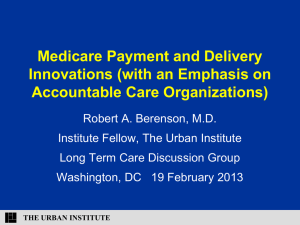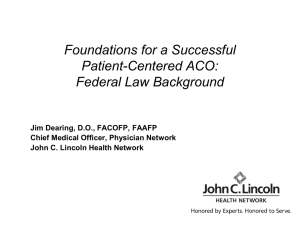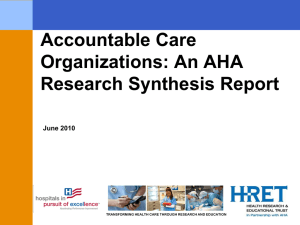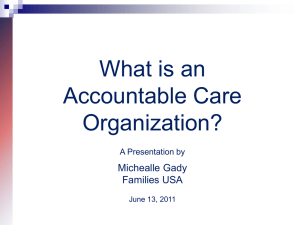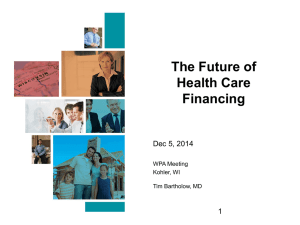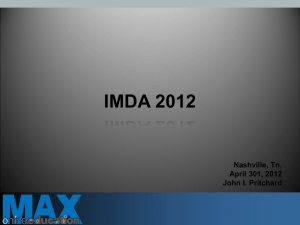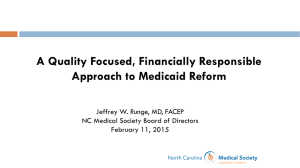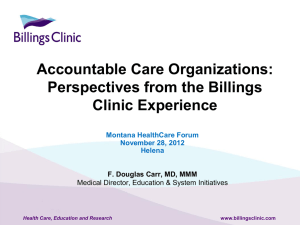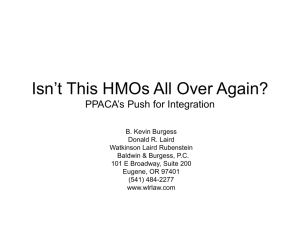Value & Coverage Issue Brief Slides
advertisement
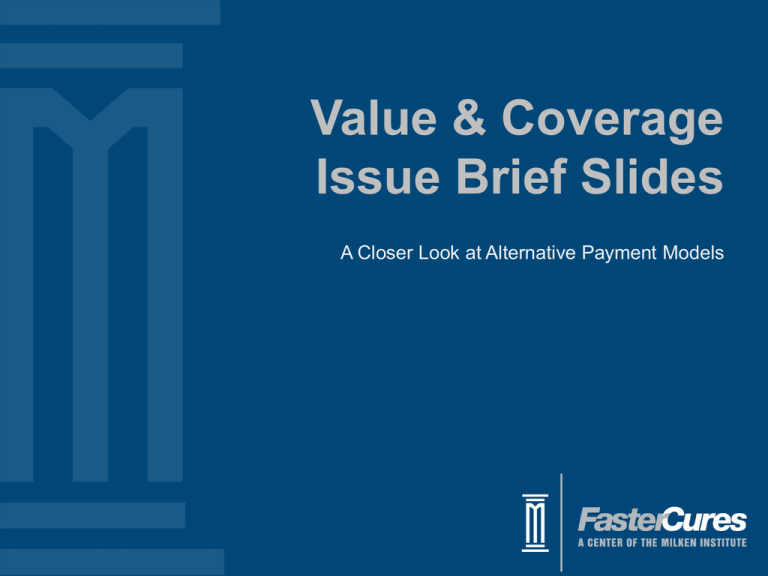
Value & Coverage Issue Brief Slides A Closer Look at Alternative Payment Models Rising Healthcare Costs 2012 U.S. Healthcare Spending $2.8 Trillion 17.2% GDP Projected 2022 U.S. Healthcare Spending $5 Trillion 19.9% GDP High Costs Have Driven Creation of Alternative Payment Models These models are gradually shifting our nation’s health care delivery and payment systems away from the traditional fee-for-service (FFS) model. • • • • Accountable Care Organizations Bundled Payment Arrangements Pay-for-Performance Initiatives Primary Care Medical Homes Traditional Fee-For-Service Model (FFS) Reimbursement model compensates providers for each service they provide. • Incentivizes providers to increase the volume (and cost) of care—through additional tests, procedures, inpatient stays and outpatient visits—rather than focusing on the quality or value of care provided to patients1 • Encourages fragmented and uncoordinated care that further increases health care costs and care inefficiencies2 Alternative Payment Models (APM) Fueled by the inefficiencies of FFS system, payers and providers have experimented with APMs to drive towards value-based care. United desire among providers, payers, policymakers, and consumers to develop integrated payment and delivery systems that provide higher quality and more cost-effective care. Accountable Care Organizations Accountable care organizations (ACOs) are networks of doctors, hospitals, and other health care providers that share responsibility for coordinating care and meeting health care quality and cost metrics for a defined patient population. Foundation of ACOs The Affordable Care Act codified the ACO model into law, creating the Medicare Shared Savings Program (MSSP), to assess this new framework.1 The private sector has also implemented several ACO variations. As of January 2014, there were 606 public and private ACOs—with more than 360 of them offered through Medicare.2 Medicare ACOs use some variation of a shared savings model with CMS, which financially rewards providers that improve quality on certain metrics while decreasing spending. ACOs by Sponsoring Entity Physician groups have become the primary sponsor of ACOs, though other organizations, such as non-profit community organizations and practice management companies, have begun to more actively sponsor ACOs. 606 Total Source: Leavitt Partners Center for Accountable Care Intelligence Medicare ACOs To earn shared savings, participating ACOs must meet 33 quality measures Source: Centers for Medicare and Medicaid Services Private Sector ACOs Types of private ACO contracts include: • Shared Savings Contracts (One-Sided Model), which rewards providers with bonuses for meeting quality measures and reducing health spending, but does not penalize them if they fail to achieve savings; • Shared Risk Payment Model (Two-Sided Model), which holds providers accountable for both bonuses and penalties; • Partial Capitation, which allows providers experienced in coordinated care to transition towards population-based alternative payment systems Private Sector ACOs Differ from Medicare ACOs Private Plans: • Are more likely to use other APMs, such as bundled payments, retainer agreements, in-kind services, and payer subsidies1 • Have contracts that tend to offer greater flexibility and customization for the providers’ and payers’ respective patient population2 • Are more willing to experiment with greater risk in their payment models3 • Sometimes enter into contracts that provide incentives for patients to seek care exclusively within the ACO network4 ACOs Lack Direct Patient Incentives ACOs do not provide patients with incentives to reward healthy behavior or stay within the ACO network for their care. Given the critical role that patients play in determining their own health outcomes, some stakeholders argue that the failure to engage patients directly could be ACOs’ biggest weakness.1 Bundled Payment Arrangements • Payers compensate providers with a single payment for an episode of care, which is defined as a set of services delivered to a patient over a specific time period. • A predetermined payment arrangement with financial and performance accountability for a specific clinical episodes • Defined on parameters of time, services, and settings • Tends to reflect the average costs of the treatments involved in an episode of care, they do not typically vary with the explicit number or mix of services provided to any individual patient.1 Elements of Episode Payment Source: Center for Healthcare Quality and Payment Reform, Transitioning to Episode-Based Payment (http://www.chqpr.org) CMS Bundled Payment Initiative Bundled Payments for Care Improvement (BCPI) The three-year project involves four different models of care and payment for participating providers.1 On January 30, 2013, CMS announced that 464 health care organizations would participate. Source: CMS: http://innovation.cms.gov/initiatives/bundled-payments/ Issues with Bundled Payments • Compensates treatments for the sick, no incentives for preventive care • Measures of care process quality, actual health outcomes are limited • Coordinating care, tracking the quality of care, and maintaining accountability for costs across providers can be difficult especially if there is not a single health system or hospital organizing a patient’s care Pay-for-Performance (P4P) Initiatives Payment models aimed at improving the quality, efficiency and the overall value of health care. The most common form of financial incentive in a P4P program is a bonus payment—an amount paid to a provider in addition to his or her usual fee for a particular service once that provider meets certain quality goals. Pay-for-Performance Quality Measures Providers are reimbursed/incentivized based on performance in these categories. P4P Models of Note There are numerous P4P initiatives, both in the private and public sectors. • Blue Cross Blue Shield Massachusetts: Alternative Quality Contract • Medicare Premier Hospital Quality Incentive Demonstration P4P Issues • Focus too narrowly on “quality” with very little consideration of cost • Incentives are too low to impact quality • Absence of quantifiable goals for many of the programs1 • little evidence regarding the impact of these programs and whether they can be successfully implemented Primary Care Medical Homes The patient centered medical home (PCMH) model facilitates the coordination of care through a patient’s primary care physician. The PCMH model integrates mental health and specialty services, and involves a team-based approach consisting of physicians, nurses and medical assistants, pharmacists, nutritionists, social workers and care coordinators. Patient Centered Medical Homes 1) Enhanced FFS evaluation and management payments 2) Additional codes for medical home activities within FFS payments 3) Per member per month medical home activities within FFS payments 4) Risk-adjusted, comprehensive per member per month payments1 Patient-Centered Medical Homes Payment system reforms are necessary for the PCMH model to recognize the additional work physicians and other providers perform in order to coordinate a patient’s care. Enhanced services include: • Additional support services; • Patient education; • Communication and care coordination among providers (facilitated by health information technology); and • Interactions with patients outside the clinical setting. Private-Sector PCMH Success Stories • Community Care of North Carolina focused its PCMH program on care coordination and primary care, and was able to decrease preventable hospitalizations for asthma by 40 percent and lower emergency visits by 16 percent1 • The Group Health Cooperative of Puget Sound reduced emergency visits by 29 percent and hospital admissions by 6 percent2 • Geisinger Health Plan program reduced hospital admission rates by 18 percent and readmissions by 36 percent per year3 Public-Sector PCMH initiatives The Affordable Care Act supports nationwide medical home demonstration projects administered by the CMS Innovation Center: • Multi-Payer Advanced Primary Care Practice (MAPCP) Demonstration1 • Comprehensive Primary Care (CPC) Initiative2 • Both initiatives implement payment models that facilitate the transformation of primary care practices into “medical homes.” • These initiatives encourage practices to use a team-based approach to care, with the patient at the center, emphasizing prevention, HIT, care coordination and shared decision making among patients and their providers. Patient-Centered Primary Care Collaborative (PCPCC) and the Milbank Memorial Fund Report January 2014 Key Findings: 1. PCMH studies have demonstrated some improvements in cost, utilization, population health, prevention, access to care, and patient satisfaction, while a gap still exists in reporting impact on clinician satisfaction; and 2. PCMH continues to play a role in strengthening the larger health care system, specifically ACOs. Key Challenges • Adequate compensation for providers coordinating care • Strength of the health care workforce for medical home, given shortage of primary care providers Challenges to Alternative Payment Models • Need for financial incentives—compensate providers for improving efficiencies in health care • Alternative Payment Model success may be limited until the Fee For Service model is removed uniformly across the country • APM coordination depends on robust data analytics and HIT infrastructure to work effectively that can be cost-prohibitive • Limitations of current quality measures may pressure reduced uptake of significant health care innovation with higher upfront costs APMs Require a Multi-Stakeholder Approach Physicians, medical societies, payers (public and private), and patient groups are continuously working to develop payment models that are specifically designed to improve patient care and save taxpayers money. Additional Resources • A Closer Look at Alternative Payment Models: Download the Full PDF • Visit FasterCures Value & Coverage Reports and Briefs Website as the Issue Brief series continues • Learn more about FasterCures’ Value & Coverage Program
